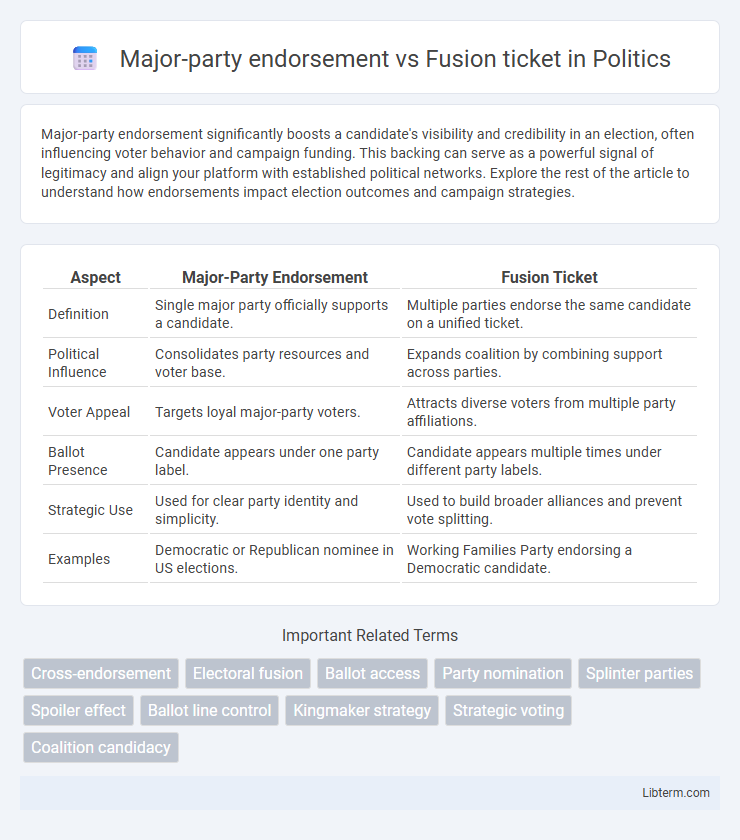Major-party endorsement significantly boosts a candidate's visibility and credibility in an election, often influencing voter behavior and campaign funding. This backing can serve as a powerful signal of legitimacy and align your platform with established political networks. Explore the rest of the article to understand how endorsements impact election outcomes and campaign strategies.
Table of Comparison
| Aspect | Major-Party Endorsement | Fusion Ticket |
|---|---|---|
| Definition | Single major party officially supports a candidate. | Multiple parties endorse the same candidate on a unified ticket. |
| Political Influence | Consolidates party resources and voter base. | Expands coalition by combining support across parties. |
| Voter Appeal | Targets loyal major-party voters. | Attracts diverse voters from multiple party affiliations. |
| Ballot Presence | Candidate appears under one party label. | Candidate appears multiple times under different party labels. |
| Strategic Use | Used for clear party identity and simplicity. | Used to build broader alliances and prevent vote splitting. |
| Examples | Democratic or Republican nominee in US elections. | Working Families Party endorsing a Democratic candidate. |
Understanding Major-Party Endorsements
Major-party endorsements occur when established political parties officially support a candidate, signaling legitimacy and increasing voter confidence through recognized party branding. This endorsement typically grants access to party resources, campaign infrastructure, and increased media attention, enhancing a candidate's visibility and influence within the electoral landscape. In contrast, a fusion ticket involves multiple parties nominating the same candidate, allowing votes from different party lines to be combined, but does not provide the concentrated support and established voter base that a major-party endorsement delivers.
What Is a Fusion Ticket?
A fusion ticket refers to a political candidacy endorsed by multiple parties, allowing a candidate to appear on the ballot under different party lines. This strategy helps consolidate votes from diverse political bases without splitting the electorate, often enhancing the candidate's chances of winning. Unlike a major-party endorsement, which involves support from a single dominant party, fusion tickets represent explicit collaboration between multiple parties to combine their electoral strengths.
Historical Context of Fusion Ticket Strategies
Fusion ticket strategies emerged prominently in the late 19th and early 20th centuries as a historical response to dominant party monopolies, allowing multiple parties to endorse a single candidate to consolidate votes against common opponents. Major-party endorsements typically involve large, established political organizations backing a candidate within a single party framework, whereas fusion tickets leverage collaboration between minor and major parties to maximize electoral impact. This approach was historically significant in states like New York and North Carolina, where fusion tickets enabled third parties and reform movements to influence election outcomes despite the prevailing two-party system.
Advantages of Major-Party Endorsements
Major-party endorsements provide candidates access to established voter bases, increasing legitimacy and voter turnout through recognized party brand strength. They often guarantee better funding, media coverage, and organizational support essential for campaign visibility. This endorsement reduces ballot confusion by aligning with a single party, simplifying voter choice and consolidating electoral efforts.
Benefits of Fusion Tickets
Fusion tickets allow multiple political parties to endorse the same candidate, increasing voter reach and pooling resources for more effective campaigns. This strategy can boost a candidate's visibility by appealing to a broader electorate, including supporters of minor parties who might not otherwise participate. The ability to appear on multiple party lines on the ballot enhances legitimacy and can lead to higher votes, improving chances of election success.
Key Differences Between Major-Party Endorsement and Fusion Ticket
Major-party endorsement occurs when a single main political party officially supports a candidate, consolidating votes under one party label, while a fusion ticket involves multiple parties nominating the same candidate to appear on ballots under different party lines. Fusion tickets allow candidates to gain broader support by appealing to diverse party bases without splitting votes, in contrast to major-party endorsements which rely solely on one party's backing. The strategic advantage of fusion tickets lies in maximizing electoral influence across party platforms, whereas major-party endorsements emphasize unity within one dominant party.
Impact on Voter Behavior
Major-party endorsements often signal candidate viability and align voter preferences with established party platforms, increasing turnout among core party supporters and persuading undecided voters. Fusion tickets, which combine nominees from multiple parties on a single ballot line, can broaden appeal by attracting diverse voter bases and mitigating the spoiler effect in closely contested races. Both strategies influence voter behavior by simplifying choices and enhancing perceived candidate legitimacy, but fusion tickets uniquely encourage coalition-building and cross-party support.
Notable Examples in Political History
Major-party endorsements, such as the Democratic Party's backing of Franklin D. Roosevelt in 1932, often provide candidates with established organizational support and voter base access. Fusion tickets, exemplified by the 1896 Populist-Democratic alliance behind William Jennings Bryan, allow multiple parties to unite behind a single candidate to broaden appeal without formally merging platforms. These strategies highlight key tactical differences in American political history, influencing electoral dynamics and party coalitions.
Challenges and Controversies
Major-party endorsements often face challenges due to internal party divisions and conflicts over candidate selection, leading to controversies around legitimacy and representation. Fusion tickets, which combine multiple parties supporting a single candidate, struggle with legal restrictions and voter confusion, complicating ballot access and campaign messaging. Both approaches encounter difficulties balancing coalition-building with maintaining clear political identities, impacting electoral outcomes.
The Future of Endorsements and Fusion Tactics
Major-party endorsements often consolidate voter support by signaling candidate legitimacy within established political frameworks, driving focused campaign resources and media attention. Fusion tickets, which allow multiple parties to endorse a single candidate, expand electoral coalitions and increase voter turnout by appealing to diverse ideological bases. The future of endorsements will likely involve hybrid strategies that integrate digital targeting and coalition-building tactics to maximize cross-party appeal and voter engagement.
Major-party endorsement Infographic

 libterm.com
libterm.com